Introduction
Looking for a warm, soothing drink with a rich roasted flavor and gentle energy? The hojicha latte might become your new favorite. This Japanese-inspired beverage is famous for its mellow, earthy aroma, creamy texture, and versatility—perfect for slow mornings, afternoon pick-me-ups, or relaxing evenings at home. In this article, you’ll discover the story behind hojicha latte, why it’s so unique, and exactly how to make a café-quality cup at home. You’ll also find creative variations and practical tips for every season.
If you’re a fan of innovative Japanese drinks, you might also enjoy the Japanese Mounjaro, a unique blend rooted in traditional ingredients that fit a healthy lifestyle.
Table Of Content
Table of Contents
The Cozy Appeal of Hojicha Latte
A Personal Story with Hojicha Latte
My first experience with a hojicha latte happened on a chilly afternoon in Kyoto, tucked inside a quiet tea shop after a long day of exploring. The smoky scent rising from the cup was instantly comforting, reminding me of toasted nuts and autumn leaves. With my first sip, I noticed the flavor was different from anything I’d tried before—smooth, a little sweet, with none of the sharpness I often find in green teas. That memory stuck with me, inspiring countless homemade lattes ever since.
Back in my own kitchen, I started experimenting. I discovered that making a hojicha latte at home is not only easy but also deeply satisfying. The process—from roasting the tea leaves (if you want to start from scratch) to whisking the warm milk—became a small ritual that helped me slow down and savor the moment. Whether I need a gentle caffeine boost or a calming evening drink, this latte always delivers a touch of comfort.
What Makes Hojicha Latte Distinct
So, what is a hojicha latte, and why is it different from your usual tea or coffee? Hojicha is made from green tea leaves that are roasted over charcoal, rather than simply being steamed and dried like other Japanese teas. This gives hojicha its signature brown color, low caffeine content, and toasty, caramel-like flavor. A hojicha latte combines this rich base with steamed or frothed milk, creating a creamy, warming drink that feels indulgent but is surprisingly gentle.
Unlike matcha or sencha, hojicha is rarely bitter. Its flavor pairs well with both dairy and plant-based milks, making it easy to customize. In Japan, it’s common to find hojicha latte on café menus, served both hot and iced, often with subtle variations. Whether you’re looking for something soothing before bed or an afternoon pick-me-up, a hojicha tea latte offers balance, taste, and a little piece of Japanese comfort in every sip.
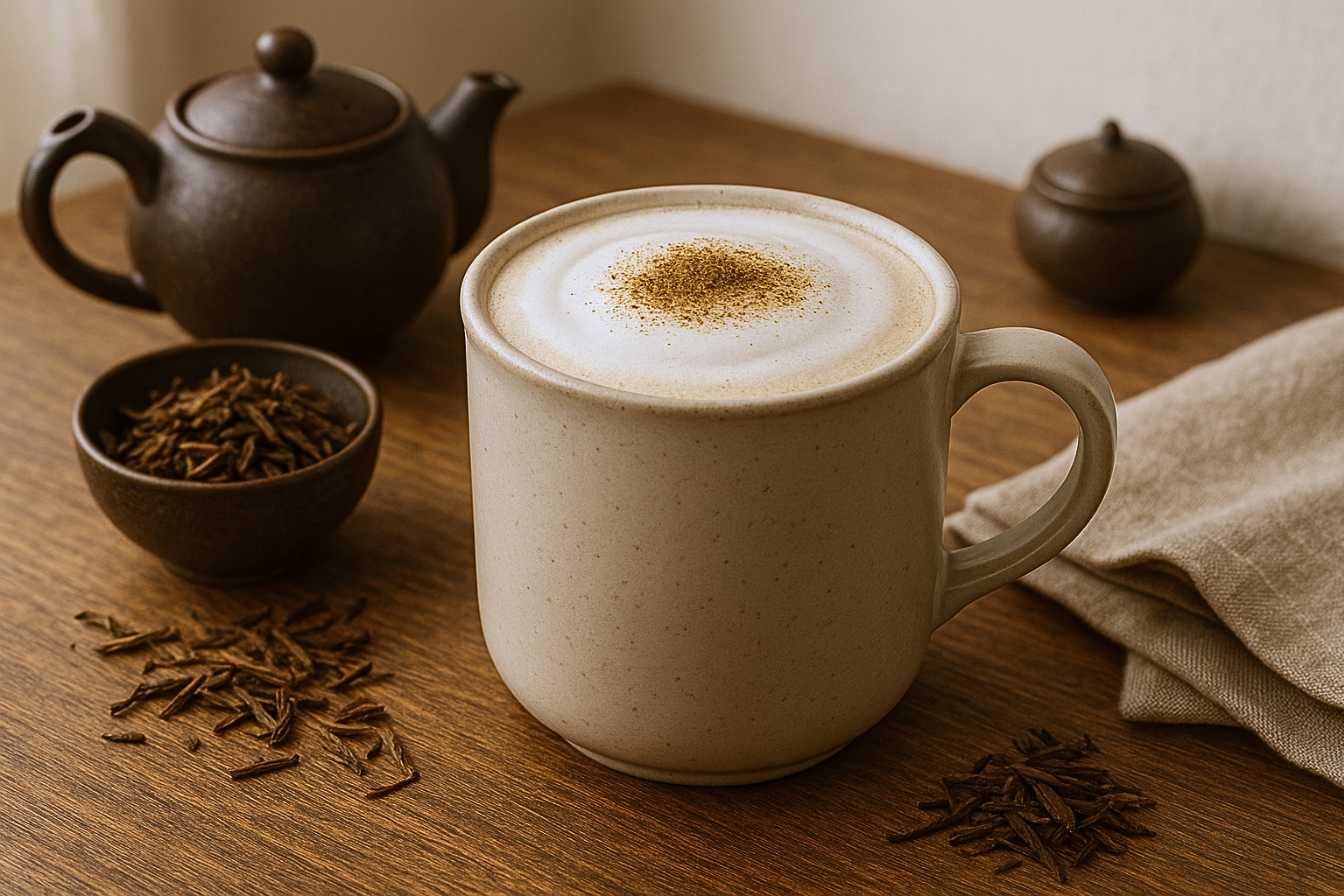
Hojicha Latte Recipe
Ingredients
Method
- Heat water to about 180°F (80°C) and steep hojicha leaves for 1–2 minutes, or whisk powder with hot water until smooth.

- Gently heat milk in a small saucepan or froth with a milk frother until warm and foamy.

- Add sweetener to milk if desired.
- Strain brewed hojicha into a mug.

- Pour hot milk over the tea, holding back foam, then top with foam.

- Sprinkle cinnamon or cocoa if you like.
- Serve warm and enjoy immediately.
Notes
- For an iced version, cool the brewed hojicha, pour over ice, and add cold frothed milk.
- Use barista-style oat milk for extra creaminess.
- Adjust tea strength and sweetness to taste.
How to make hojicha latte
Key Ingredients for a Perfect hojicha latte recipe
A great hojicha latte starts with just a few quality ingredients, but the details make all the difference. First, you need hojicha—Japanese roasted green tea. You’ll usually find it sold as loose leaf, but it’s also available in finely milled powder, perfect for lattes. The roasting process removes bitterness and gives hojicha its signature earthy, caramel notes.
Next is your milk of choice. Traditional recipes use whole milk, which creates a creamy texture and sweet flavor. For a lighter or dairy-free drink, oat, almond, or soy milk work beautifully, frothing up nicely while letting the roasted tea shine. Natural sweeteners like honey, maple syrup, or monk fruit can add a touch of sweetness if you like. A pinch of cinnamon or vanilla extract also brings a gentle twist, though many purists enjoy it plain to appreciate the true flavor of hojicha.
For best results, always use filtered water for brewing. Heating the milk gently, instead of boiling, keeps it smooth and helps preserve its flavor. With just these basic ingredients, you can make a café-worthy hojicha tea latte at home, tailored to your preferences and routine.

Step-by-Step hojicha latte recipe at Home
Making a hojicha latte recipe is easy, even if you’re new to Japanese tea drinks. The whole process takes less than ten minutes and turns a handful of ingredients into a creamy, aromatic treat. Here’s how you can create this soothing latte at home:
Step 1: Begin by scooping out one to two teaspoons of loose hojicha leaves or using one teaspoon of hojicha powder.
Step 2: Bring filtered water to a near boil (about 180°F or 80°C), then steep the tea leaves for 1–2 minutes, or whisk the powder with a splash of hot water until smooth and fragrant.
Step 3: As the tea brews, slowly warm your preferred milk in a small pot or use a milk frother to create foam.
Step 4: If you like a touch of sweetness, add honey, maple syrup, or a sugar-free sweetener to the milk as it warms.
Step 5: Strain the brewed hojicha into your favorite mug.
Step 6: Pour the hot, frothed milk over the tea, holding back the foam with a spoon, then spoon the remaining foam on top for a café-style finish.
Step 7: For added aroma, you can dust the top with a bit of cinnamon or cocoa powder if desired.
Step 8: Sip slowly and enjoy while warm.
With just a bit of care, you’ll get a silky, balanced hojicha tea latte every time.
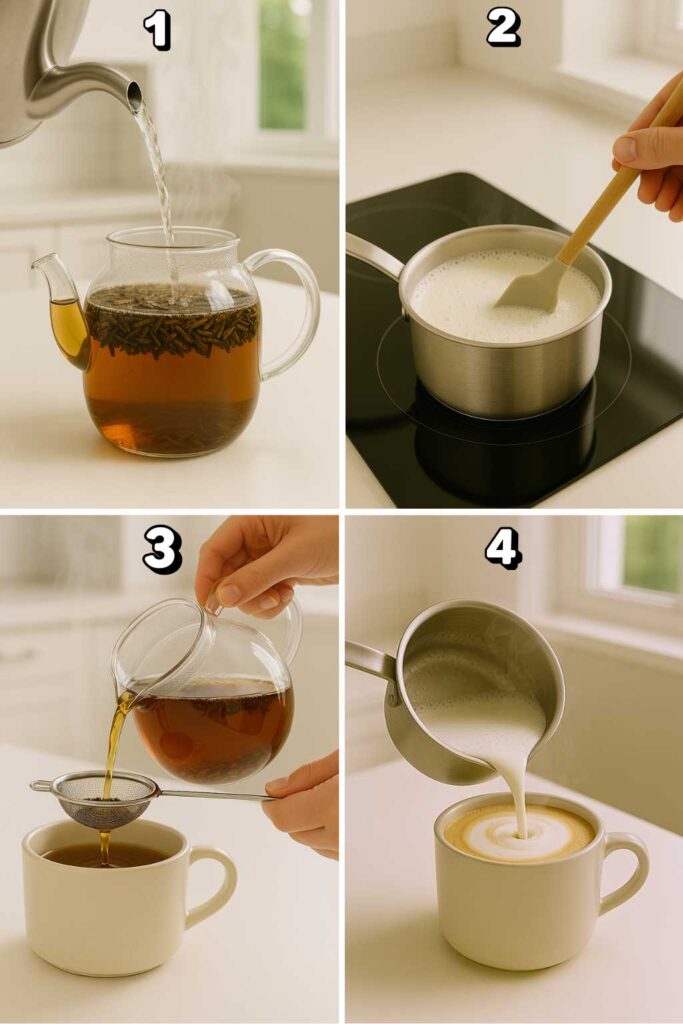
Nutrition Snapshot: What’s in Your Cup?
Hojicha latte is a smart choice for those who want comfort without heavy calories or caffeine. Here’s a quick nutrition snapshot for a standard cup (using unsweetened oat milk):
- Calories: About 60–90
- Carbohydrates: 8–13 grams
- Protein: 2–3 grams
- Fat: 2–4 grams
- Fiber: 1–2 grams
- Caffeine: 7–20 mg (much lower than coffee or matcha)
- Antioxidants: Moderate to high, depending on the tea quality
Hojicha’s low caffeine and rich antioxidant content make it a gentle drink that supports relaxation and hydration. If you’re looking for more low-calorie drinks that fit a mindful routine, try our Mounjaro Recipe, another delicious option for anyone focusing on wellness. When you choose unsweetened milk and skip added sugars, your hojicha latte remains a healthy, comforting part of any day.
Variations and Creative Serving Ideas
Plant-Based & Dairy-Free Options
One of the most appealing qualities of a hojicha latte is how effortlessly it adapts to all kinds of dietary preferences and lifestyles. If you follow a vegan or dairy-free diet, you’ll find that swapping out cow’s milk for a plant-based option is both simple and delicious.
Oat milk is especially popular thanks to its naturally sweet and creamy texture, which complements the roasted flavor of hojicha perfectly. Almond milk delivers a lighter, nutty undertone, perfect for those who enjoy a more delicate flavor. Coconut milk adds a subtle, tropical sweetness, while soy milk offers a smooth and neutral base that lets the tea’s character shine through.
For a touch of luxury, cashew or macadamia milk make your hojicha latte extra silky and rich, closely mirroring the experience of a traditional café drink. The versatility of these plant-based milks means you can experiment freely to find your ideal combination—whether you want extra creaminess, a specific flavor note, or a lighter finish.
Pairing and Serving Ideas
A hojicha latte is more than just a drink—it’s a comforting pause you can fit into any part of your day. Many enjoy it as a gentle start to the morning, a calming afternoon treat, or even as a bedtime ritual thanks to its low caffeine. The nutty, toasted notes pair well with light snacks like almond cookies, rice crackers, or a slice of banana bread. For a satisfying, protein-rich option, try it alongside Cottage Cheese Bagels, which make an excellent breakfast or midday snack. Hojicha latte also complements fruit, especially berries and citrus, and it can stand on its own as a cozy treat while you read or unwind.
Serve it in your favorite mug or a tall glass with plenty of milk foam. To recreate a café-style touch, finish with a light sprinkle of hojicha powder, cinnamon, or a bit of cocoa on top. Whether you make it hot or iced, the ritual of preparing and savoring a hojicha latte is a simple way to bring a little comfort and Japanese tradition to your daily routine.
Conclusion
The hojicha latte delivers comfort, warmth, and a touch of Japanese tradition in every sip. Its creamy, roasted flavor is a welcome companion for mornings, afternoons, or quiet evenings at home. Whether you like it hot, iced, or dressed up with fun toppings, this latte adapts easily to your taste. Take some time to try out different milks, sweeteners, or spices until you discover the combination you love most. Each cup is a small invitation to pause, slow down, and savor life’s little joys—one soothing sip at a time.
Looking for more healthy and comforting drink ideas? Visit my Wellness board on Pinterest for fresh recipes, inspiration, and wellness tips .
If you’re exploring gentle dietary changes, you’ll find helpful tips in our guide on How to Manage Sulphur Burps Zepbound, which shares practical solutions and soothing recipes.
Frequently Asked Questions about Hojicha Latte
Does hojicha have health benefits?
Yes, hojicha contains antioxidants and can support relaxation. Its low caffeine content makes it gentle on the stomach and suitable for those seeking a calming drink
What does Hojicha tea latte taste like?
A hojicha tea latte has a toasty, nutty flavor with a hint of caramel and earthiness. The milk creates a creamy, comforting texture that complements the roasted tea.
How long does hojicha last?
Loose hojicha tea will keep its freshness for up to a year if stored in an airtight container, away from light and moisture. After making your latte, it’s best to drink it the same day to enjoy the fullest flavor.
How much hojicha to use for a latte?
Generally, use 1 teaspoon of hojicha powder or 2 teaspoons of loose hojicha tea per cup for a balanced, rich flavor.
Is hojicha better hot or cold?
Hojicha lattes are delicious both hot and cold. Serve hot for a cozy experience or iced for a refreshing treat.
What milk is best for Hojicha latte?
Choose the milk you enjoy most. Oat, almond, dairy, soy, or coconut all work well, so you can adjust for your taste and dietary needs.
Does hojicha taste good with milk?
Absolutely! Milk brings out the caramel notes and creaminess of hojicha, making it a favorite way to enjoy this tea.
Does Hojicha latte have sugar?
You control the sweetness. The classic recipe is unsweetened, but you can add honey, maple syrup, or your preferred sweetener.
Can you drink hojicha latte at night?
Yes, you can. Hojicha’s low caffeine means it won’t keep you awake, making it a lovely option for a nighttime treat.

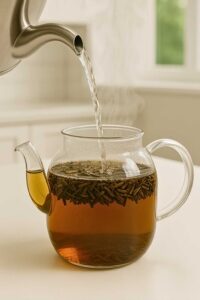
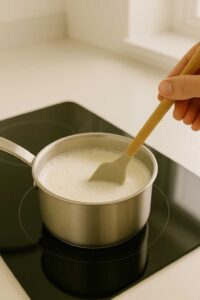
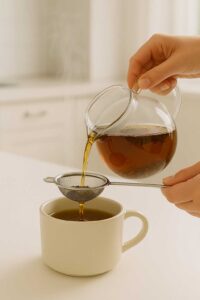
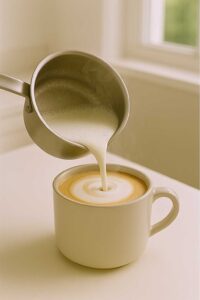
1 thought on “Hojicha Latte: How to Make and Enjoy Japan’s Toasted Tea Classic”